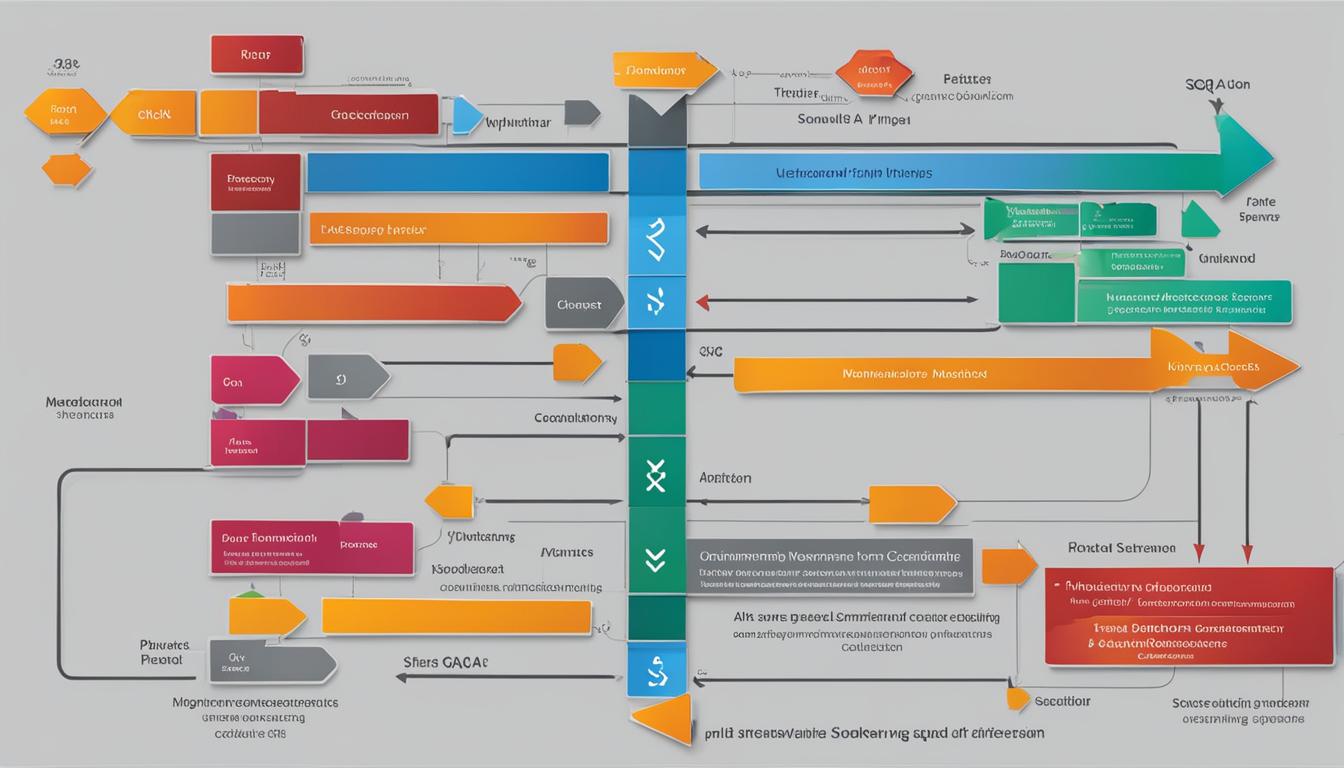Companies often encounter a challenging dilemma in their pursuit of top-notch software quality: they must balance thorough testing with operational efficiency.
This is where QA as a Service comes into play. It's a concept that's gaining traction in the tech world, offering a way for businesses to offload their testing needs to specialized providers.
But what exactly does this model entail, and how can it benefit organizations in the long run?
We'll explore these questions and more as we dive into the world of QAaaS and its potential impact on software development.
Key Takeaways
- QA as a Service offers a comprehensive approach to software testing and quality assurance, including functional testing, regression testing, load testing, security testing, and usability testing.
- It is a scalable option that benefits software development companies, SMEs, startups, ISVs, and government organizations, providing high-quality software products while reducing overhead costs.
- QA as a Service ensures predictable spending for QA testing and offers fully scalable QA needs based on client requirements, eliminating the need to manage a vendor.
- It provides benefits such as time and cost savings, adherence to quality standards, enhanced customer satisfaction, risk mitigation, and efficiency in development, along with utilization of testing tools, services, and automation testing.
What Is QA as a Service?
When considering the concept of QA as a Service, it becomes clear that outsourcing software testing needs to specialized companies offers significant time and cost-saving advantages for businesses. QA as a Service, or QAaaS, is a comprehensive approach to software testing and quality assurance. This service encompasses a wide range of testing activities such as functional testing, regression testing, load testing, security testing, and usability testing, catering to the diverse needs of the software development process.
One of the key benefits of QA as a Service is its scalability, making it an attractive option for startups and small businesses. This scalability provides the flexibility to adapt to changing testing requirements without the need for substantial infrastructure investments. Moreover, QA as a Service isn't limited to specific industries or company sizes. It can benefit software development companies, SMEs, startups, ISVs, and government organizations by ensuring software quality and meeting customer expectations.
Furthermore, QA as a Service leverages advanced technologies such as AI-driven testing, machine learning, and AI in software testing to enhance testing efficiency and effectiveness. These technological advancements play a crucial role in streamlining the QA process and ultimately improving the overall quality of software products.
Benefits of QA as a Service

The benefits of QA as a Service encompass delivering high-quality software products, reducing overhead costs, providing predictable spending for QA testing, and offering fully scalable QA needs based on client requirements. By leveraging a QA service provider, companies can ensure that their software meets high standards of quality. This approach not only reduces the burden on the development team but also allows for a more efficient and effective testing process. Below is a table highlighting the key benefits of QA as a Service:
| Benefits of QA as a Service |
|---|
| Delivers high-quality software products |
| Reduces overhead costs |
| Provides predictable spending for QA testing |
| Offers fully scalable QA needs based on client requirements |
| Ensures quality results without the need to manage a vendor |
As companies strive to streamline their testing approach and optimize software quality assurance, engaging with a QA testing company for testing as a service can yield significant advantages. The ability to scale QA needs based on specific project requirements and the assurance of predictable spending make QA as a Service a valuable asset for companies seeking to enhance their software development processes.
How Does QA Work as a Service?
So, how does QA work as a service?
Let's start by providing an overview of the QA process and its components.
We'll then explore the specific benefits that QA as a service can offer to businesses.
Let's delve into the details of how this approach can enhance software quality and overall customer satisfaction.
QA Process Overview
With the rise of QA as a service, the process of software testing has evolved into a streamlined and cost-effective solution for companies seeking to outsource their QA needs.
QA services offer a comprehensive approach to the testing process, ensuring high quality and reliability. The testing tools and technologies used in QA as a service enable continuous testing, providing real-time feedback on the quality of the software.
Additionally, companies can maintain control over the testing process, ensuring that it aligns with their specific requirements and standards. Moreover, data security is a top priority, with service providers implementing robust measures to safeguard sensitive information throughout the testing process.
This comprehensive approach ensures that companies can confidently outsource their QA needs while maintaining high standards of quality and security.
Benefits of QA
Utilizing QA as a service provides companies with the opportunity to outsource their software testing needs to specialized providers, resulting in significant time and cost savings while ensuring high-quality software products. Service providers offer a range of testing techniques, including functional, regression, load, security, and usability testing, conducted by experienced QA teams. This approach guarantees adherence to quality standards and the inclusion of robust security features. Furthermore, companies can scale their QA needs based on their requirements, reducing overhead costs and ensuring predictable spending. By outsourcing their testing needs to a software testing company, businesses can enhance customer satisfaction through the delivery of high-quality results without the hassle of managing vendors, thus fostering increased customer loyalty.
| Benefits of QA as a Service | |
|---|---|
| Time and cost savings | High-quality software products |
| Adherence to quality standards | Scalable QA needs based on client requirements |
| Enhanced customer satisfaction | Robust security features |
Advantages and Disadvantages of QA

Let's take a closer look at the advantages and disadvantages of Quality Assurance.
Understanding the benefits and drawbacks of QA can help us make informed decisions about its implementation.
Advantages of QA
QA provides numerous advantages, including reducing the risk of software failure, increasing customer satisfaction, and speeding up the software development process. The benefits of QA are extensive, and some of the key advantages include:
- Risk Mitigation: QA helps in identifying and fixing defects and bugs, reducing the risk of software failure and financial losses.
- Enhanced Customer Satisfaction: By ensuring the delivery of high-quality software applications, QA contributes to increased customer satisfaction and loyalty.
- Efficiency in Development: QA streamlines the software development process, identifying issues early on and enabling their prompt resolution, which ultimately accelerates the development cycle.
By leveraging a wide range of testing tools, testing services, and automation testing, the QA team can significantly enhance the quality and efficiency of the software development process, resulting in substantial benefits for the organization.
For more information on QA as a Service, visit our privacy policy.
Disadvantages of QA
Implementing Quality Assurance (QA) processes can present several challenges and limitations that organizations need to carefully consider.
Traditional QA can be time-consuming, requiring a significant upfront investment in resources, infrastructure, and a range of testing tools, impacting both time and money.
Additionally, in-house testing teams may struggle to cover all scenarios, potentially leading to undetected defects in the software.
Furthermore, the need for in-house testing of sensitive data makes it challenging to maintain security and compliance.
Relying solely on QA can also create a false sense of security, leading to a lack of attention to detail in the development process.
Who Can Benefit From QA as a Service?

Small and medium-sized enterprises (SMEs) stand to benefit significantly from QA as a Service due to its cost-effectiveness and efficiency in the absence of an in-house testing team.
However, various other entities can also benefit from this service, including:
- Software Development Companies: Companies that develop software can benefit from QA as a Service by ensuring that their products meet quality standards and perform as expected. This can lead to improved customer satisfaction and reduced post-release issues.
- Startups: For startups, QA as a Service provides a means to ensure thorough testing of their software without the need to invest in an in-house testing team. This allows startups to focus on their core competencies while ensuring the quality of their products.
- Independent Software Vendors (ISVs): ISVs can leverage QA as a Service to ensure that their software meets quality standards and customer expectations. This can help them gain a competitive edge in the market by delivering high-quality, reliable software solutions.
Challenges of QA as a Service

Adapting to diverse software applications and platforms presents a significant challenge for providers of QA as a Service, especially when considering the varying needs of different clients. The table below outlines the key challenges faced by companies offering QA as a Service:
| Challenge | Description |
|---|---|
| Diverse Software Applications | Testing across a wide range of software applications requires expertise in various technologies and domains. |
| Communication and Client Requirements | Maintaining consistent communication and understanding client needs across multiple projects is essential for delivering effective testing services. |
| Security and Confidentiality | Ensuring the security and confidentiality of client data while testing software applications is crucial for building trust and maintaining integrity. |
The challenges in QA as a Service are complex and demand meticulous attention. Balancing the speed of testing with the thoroughness required to ensure software quality, and managing the scalability and flexibility of QA services to meet the varying needs of different clients are also critical. With product development cycles becoming more dynamic, addressing these challenges is vital for companies providing QA as a Service.
Common Misconceptions

Despite common misconceptions, QA as a service offers a range of benefits for businesses of all sizes, providing specialized expertise and advanced testing tools to improve software quality and time-to-market.
It's important to dispel some common misunderstandings about QA as a service:
- Not Just for Startups: QA as a service isn't exclusively for startups and small businesses. Larger companies can also benefit by expanding their testing coverage or freeing up their in-house testers' time.
- Beyond Cost Savings: Contrary to popular belief, QA as a service isn't solely about cost savings. It provides access to advanced testing tools, specialized expertise, and a faster time-to-market for software products.
- Customizable and Scalable: Some may assume that QA as a service is a one-size-fits-all solution. However, it offers flexibility and scalability to adapt to the specific requirements of different projects and companies.
Popular QA as a Service Provider Includes

How do popular QA as a service providers ensure a comprehensive range of testing services to meet the diverse needs of businesses developing software applications? Popular QA as a service providers achieve this by offering a wide array of testing services, including functional testing, load testing, security testing, and more. They have a team of experts dedicated to ensuring that software applications are thoroughly tested across various platforms and devices. These providers also offer test execution and identification of defects to guarantee that the software meets quality and security standards. By leveraging the expertise and resources of these QA service offers, businesses can save time and money, as well as gain access to specialized testing knowledge and advanced tools. Furthermore, subscribing to their services can provide valuable insights into the latest industry trends, which is beneficial for businesses seeking to stay ahead in the competitive software development landscape.
| Testing Services | Test Execution | Software |
|---|---|---|
| Functional Testing | Comprehensive testing | Quality |
| Load Testing | Identification of | Security |
| Security Testing | Defects | Standards |
Uses of QA as a Service

Popular QA as a service providers ensure a comprehensive range of testing services to meet the diverse needs of businesses developing software applications. The uses of QA as a service encompass finding and fixing bugs before projects go to market. This approach offers flexibility and scalability and can be utilized throughout an entire project or for specific features.
The level of detail provided by QA as a service can be adjusted to the specific needs of a project, making it a versatile option for businesses. Additionally, QA as a service can act similarly to traditional QA services, but with more flexibility, making it an attractive option for businesses with varying needs.
Uses of QA as a Service:
- Comprehensive Testing: QA as a service provides a wide array of testing services, ensuring that all aspects of a software product are thoroughly examined.
- Bug Fixing Before Launch: It helps in identifying and rectifying bugs before the software project is launched, ensuring a smoother user experience.
- Scalable Detail: This approach allows for the adjustment of the level of detail in testing to match the specific requirements of a project, providing tailored solutions for different industries and use cases.
Frequently Asked Questions
What Is QA as a Service?
We define QA as a service as the outsourcing of software testing needs to specialized companies. This allows for expert teams experienced in testing software applications across different platforms and devices to provide a range of QA services including functional testing, regression testing, load testing, security testing, and usability testing.
The scalability of QA as a service makes it attractive for startups and small businesses, saving time and money while ensuring software quality.
What Does QA Mean in Saas?
In SaaS, QA stands for Quality Assurance. It involves ensuring that software products meet high-quality standards.
Did you know that 88% of SaaS companies agree that QA is crucial for customer satisfaction and retention?
QA in SaaS involves rigorous testing to identify and fix any issues, ensuring a seamless user experience. This attention to detail is essential for maintaining customer trust and loyalty in the competitive SaaS market.
What Are the 4 Types of Quality Assurance?
We'll discuss the four types of quality assurance.
Functional testing evaluates software functionality, while performance testing assesses software under varying loads.
Security testing focuses on protecting sensitive data and preventing unauthorized access, and usability testing ensures a user-friendly interface.
These types collectively ensure software quality. Each type targets specific aspects of software performance, security, and user experience, contributing to overall quality and reliability.
This comprehensive approach is crucial for delivering high-quality software products.
Is Quality Assurance a Service?
Yes, quality assurance is a service. Our team ensures high-quality products through rigorous testing and analysis. We implement best practices to maintain standards and meet client needs.
Our dedication to quality makes us a reliable partner for delivering top-notch products and services. We offer a comprehensive range of testing solutions to guarantee excellence in every aspect of our work, providing peace of mind to our clients and end-users.
Conclusion
In conclusion, QA as a Service is a game-changer for businesses looking to elevate their software testing game. With a team of experts handling everything from functional testing to security testing, the sky's the limit for software quality.
Say goodbye to sleepless nights over buggy applications and hello to seamless, efficient testing processes. QAaaS is the key to unlocking your software's full potential and staying ahead of the competition.
Don't miss out on this opportunity to revolutionize your testing approach!
Rick, our Software Quality Assurance Writer, is the creative force behind many of our insightful articles and course materials. His unique background in software development, fused with his natural flair for writing, allows him to convey complex QA concepts in a way that is both informative and captivating. Rick is committed to keeping abreast of the latest trends and advancements in software testing, ensuring that our content remains not just relevant, but at the forefront of the field. His significant contributions are instrumental in helping us fulfill our mission to deliver premier QA education.










